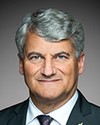Thank you for the opportunity to appear before you today as you continue your important work on clean technologies in Canada.
My name is Ian Robertson. I'm the CEO of the Greater Victoria Harbour Authority.
To start, I wish to acknowledge with respect the Lekwungen peoples, on whose traditional territories we operate, and the Songhees Nation and the Esquimalt Nation, whose historical relationships with the land continue to this day. Both nations form part of our eight member agencies.
For those who are not aware, the Greater Victoria Harbour Authority is a community-based not-for-profit organization that is committed to the stewardship and sustainable growth of Victoria's dynamic working harbour. Our organization is governed by a 13-member board of directors, represented by four independent members and eight member agencies.
The Victoria cruise terminal at the Breakwater District is Canada's busiest port of call. Victoria is an essential Canadian cruise port of call for vessels operating in the coastal waters of southeast Alaska and British Columbia. In 2022, Victoria will have welcomed 330 ship calls carrying 725,000 passengers.
In 2018, greenhouse gas emissions from the Victoria cruise terminal were equivalent to just over 3,200 cars on the road per year. Since 2010, criteria air contaminants have decreased by 41%; sulphur dioxide has been reduced by 95%; particulate matter has been reduced by 79%; and cruise passenger counts have increased by 45%, while GHG emissions have increased by only 19% due to increasingly stringent emission standards. Cruise emissions account for 96% of all emissions at the Victoria cruise terminal.
In January 2019, we contracted Synergy Enterprises to develop a full-scale emissions inventory for the terminal to help identify where we could make improvements to emissions under our control and jurisdiction. After extensive study of various shore power technologies, frequency conversion technology installed with the shore power connection has been recommended to optimize for variability in types of cruise and non-cruise vessels, further adding to the long-term diversification of the deepwater port.
The study found that by implementing a shoreside power system at two berths, the estimated annual reduction of carbon emissions is between 6,400 and 7,300 tonnes of CO2. This equates to a total savings of just over 131,000 tonnes of CO2 through 2040 over a no-action scenario. Sulphur dioxide and nitrogen oxides would also similarly reduce as well. These reductions would be in addition to gains made by the cruise industry to meet the global challenge of reducing the rate of carbon emissions across the fleet by 40% by 2030.
As other ports in North America and elsewhere have seen, shore power technology drastically reduces emissions where vessels are in port, as well as reducing emissions from buildings and fleet vehicles, along with other vessels being able to plug into the shore power infrastructure. This is an important move that is being adopted by the cruise lines themselves. By 2030, 85% of all vehicles calling to the Victoria cruise terminal will be shore power-capable. That number will—





